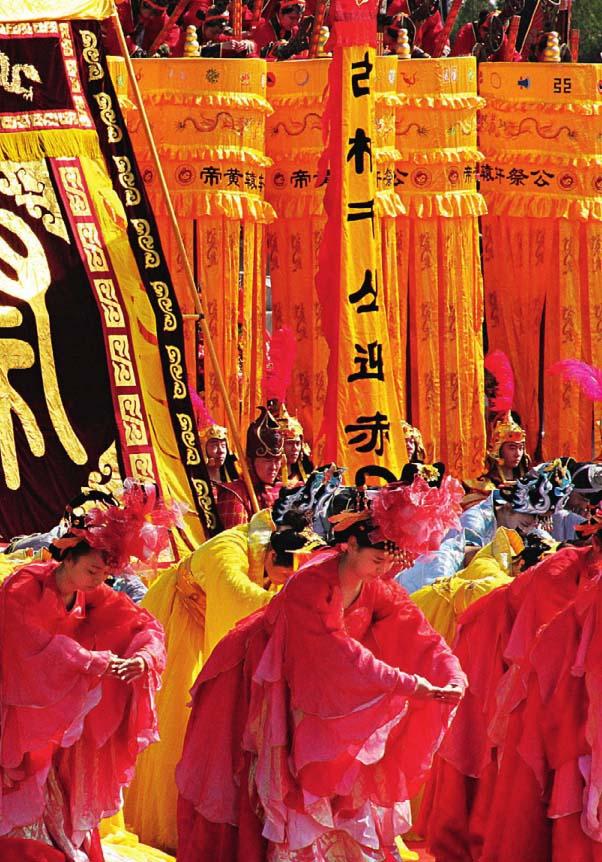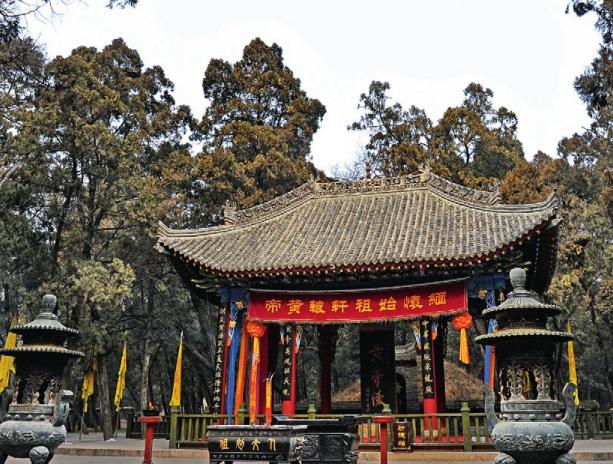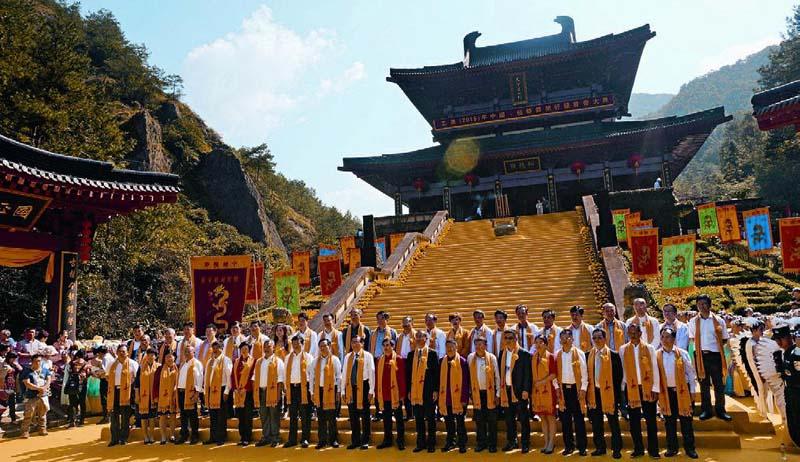The Revered Yellow Emperor:Grandest Sacrificial Ceremony



OFFERING sacrifices has been integral to the Chinese rituals of praying to gods and ancestors since time immemorial. Ancients believed that the soul could exist without the body, and making sacrifices derives from this belief.
The intention behind this cultural ritual is to show respect for the departed as one would if they were still alive. Certain sacrificial ceremonies held to cherish the memory of the departed are held on special days. They are a medium of expression for continuing respect for forbears, and confirmation of the existence and continuation of a family, ethnic group, and the nation.
Since the legendary Yellow Emperor made inestimable contributions to the Chinese nation, his descendants pay tribute to him through majestic rites.
A tribal chieftain more than 5,000 years ago, the Yellow Emperor conquered various warlike tribes and became head of a tribal confederation. He is thus regarded as the first ancestor of the Chinese civilization.
Legend has it that the Yellow Emperor could speak soon after his birth, and that by the time he was 15 years old there was nothing he did not understand. At the age of 20 he inherited the chieftain title of the Youxiong tribe, which later gathered strength and steadily expanded its territories. At that time, tribal wars had wrought chaos on the Central Plains. The Youxiong chieftain led his tribe to conquer many weaker and smaller tribes, and so unified the Yellow River basin. Soon afterwards, he united with the Yan Emperor to defeat the mythological warrior Chiyou, and established the basic structure of the Chinese culture. Chinese people have since regarded themselves as descendants of the Yan and Huang Emperors.
According to historical records, after the Yan Emperor passed away, the Yellow Emperor governed for some considerable time. It was then, as legend has it, that the Chinese people began to write characters, devised the calendar, invented musical instruments, and developed medical science, sericulture, and grain planting. The Yellow Emperors reign is regarded as having established the development direction of Chinese culture based on agriculture. His feats were lauded as constituting the vital spiritual bond uniting the Chinese nation.
After the Yellow Emperors death, people built temples and altars to him and performed complex and ornate sacrificial rituals that continued for thousands of years. His main concepts, such as combining civil and military forces, nurturing virtue by punishing evil, the rule of law, and governing through non-action, all helped to facilitate Chinas grand unification after years of warfare. In addition to being regarded as a blood ancestor, the Yellow Emperor also personified the spirit of the Chinese nation, like a banner leading the peoples rise from the chaos of war to social unification, harmony and stability.
Public Commemorations
According to documented records, two types of sacrificial rituals are performed in honor of the Yellow Emperor. One is held in temples countrywide, the other in his mausoleum. Both have historical origins that reflect the peoples identification with and worship of their primary ancestor. Historical progress has made this Chinas most ceremonious and sacred commemorative event.
Ritual worship in the Yellow Emperors mausoleum is of long standing. The Yellow Emperor is believed to have been buried on Qiaoshan Hill, one kilometer north of Huangling (literally the Yellow Emperors mausoleum) County in Shaanxi Province. As early as 110 BC, Emperor Wudi of the Han Dynasty (202 BC-AD 220) performed ritual obeisance to the Yellow Emperor there, the first ever recorded in historical documents. During the Tang Dynasty (618-907), a temple dedicated to the Yellow Emperor was built on the site. The succeeding Song Dynasty (960-1279) Imperial Court held sacrificial ceremonies in the mausoleum temple every three years.
In 1374, Zhu Yuanzhang, founder and first emperor of the Ming Dynasty (1368-1644), issued an imperial edict on the building of a statue of the Yellow Emperor in the great hall of the mausoleum. Throughout the dynasty, the mausoleum was regarded as a shrine specifically for emperors performance of ritual sacrifices to their ancestor. Details of elegiac addresses, sacrificial dates, offerings, and participating officials were also recorded there on stone tablets. Two military officers were assigned to protect this holy site. Emperors personally wrote funeral orations in preparation for the three-yearly grand sacrificial ceremonies at Qiaoshan Hill.
Qing Dynasty (1644-1912) emperors followed the routine rituals at the mausoleum temple every three years. In addition, they also personally presided over sacrificial ceremonies at the Imperial Temple of Emperors in Beijing. When the Republic of China was founded in 1912, Dr. Sun Yat-sen, known as “father of the republic,” wrote a funeral oration and sent high-level officials to offer sacrifices at Qiaoshan Hill, so reflecting a strong sense of national confidence and pride.
Statistics show that Ming Dynasty emperors sent officials to perform sacrificial rituals at the mausoleum 14 times. During the Qing Dynasty these rituals were performed 30 times, and 25 times during the Republic of China period. In 1937, the ruling Kuomintang party and opposing Communist Party of China(CPC) held a joint memorial ceremony at the mausoleum of the Yellow Emperor, for which Mao Zedong wrote the CPC elegiac address.
Over the past 2,000 years, sacrificial ceremonies at the mausoleum, both official and civil, have become growingly influential.
Great importance has also been accorded to renovations. Since first constructed in the Han Dynasty, the mausoleum has been rebuilt 21 times, including its relocation in the Song Dynasty.
After several abeyances during the mid-20th century, in 1980 the public commemoration ceremony resumed. State leaders have annually attended the public sacrificial ritual there since 1994. In 2006, the public commemoration ceremony was included in the first batch of national intangible cultural heritage.
Grand Hometown Ceremony
The birthday of the Yellow Emperor is on the third day of the third lunar month, a day when boat outings are traditional. Ancients began paying tribute to the Yellow Emperor on this date during the 8th century BC.
The Yellow Emperor was born in what is today Xinzheng City in Henan Province, according to historical research. Historical documents show that this sacrificial ceremony, which thrives to this day, became a tradition during the Tang Dynasty.
The local Xinzheng City government has followed this tradition of grand worshipful ceremonies on the birthday of Yellow Emperor since the 1990s. Each year thousands of Chinese people at home and from abroad go there to reaffirm their roots and worship their ancestor.
The ceremony comprises nine parts, namely, firing a 21-gun salute, the respectful offering of a bouquet of flowers, burning incense, worship, reading the elegiac address, singing a rousing song, dances to the accompaniment of music, blessing the country, and offering prayers for the unity of nature and humankind.
This grand ceremony carries forward the Chinese peoples excellent traditional culture and cherishes their ancestors merits and virtues. It also highlights affirmation of their roots and esteem for their ancestors, so symbolizing continuation of the bloodline.
In 2008, the grand ceremony held in the hometown of the Yellow Emperor was included in an extension project of the first batch of national intangible cultural heritage.
Ceremony in Jinyun County
Located in Lishui City of Zhejiang Province, Jinyun County has been site of the Yellow Emperors Memorial Hall since the Tang Dynasty. Legend has it that he became an immortal here.
Jinyun was the name of an ancient clan that was originally part of the Yan Emperors tribe. Since the clan lived near the Youxiong tribe of the Yellow Emperor, they shared a similarly nomadic lifestyle and formed close contacts. The Jinyun later merged with the Youxiong tribe. After the Yellow Emperor unified the Central Plains, the clan was given territory in todays Zhejiang in southeastern China. Meanwhile, the Yellow Emperor culture spread and flourished in northern China.
After long-term development, people of the Jinyun clan integrated with local inhabitants but did not forget their roots. In the fourth century they built Jinyun Hall in honor of the Yellow Emperor.
The fourth century is a special period in Chinese history, one in which people suffered from incessant wars, but that also opened the way for extensive religious development. On the other hand, many Han people moved south. Establishment of Jinyun memorial hall provided them with spiritual solace, and became a sacred site where the people who had resettled in South China reaffirmed their roots and worshipped the Yellow Emperor.
In 748, Emperor Xuanzong of the Tang Dynasty issued an imperial edict changing the name“Jinyun Hill” to “Xiandu Hill,” and “Jinyun Hall” to the “Yellow Emperors Memorial Temple.” This formed the two ceremonial patterns in China, one in the mausoleum in the north, and the other in the memorial temple in the south.
The sacrificial ceremony in Jinyun County has gradually taken shape in scale and ritual. Tomb-sweeping Day is designated as a folk worship festival, and the Double Ninth Festival as a day for public sacrificial rituals. Combining local traditional folk customs, these ceremonies inherit and carry forward Chinas traditional culture and enhance national cohesion.
In 2011, the sacrificial ceremony in Jinyun County was included on the list of national intangible cultural heritage.

